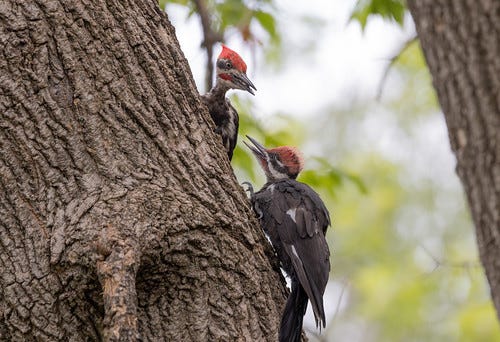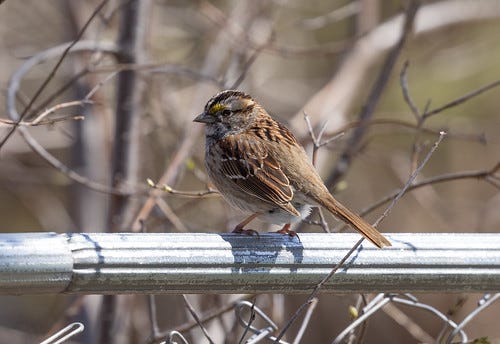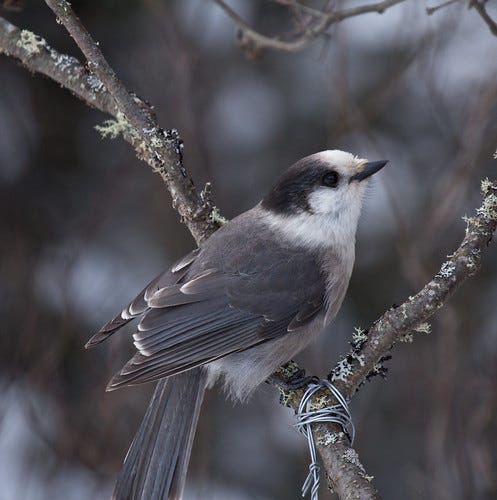(Listen to the radio version here.)
This is the strangest winter I can remember. I’m sure there were winters with less snow during my childhood in Chicago, almost 500 miles south of here, but I can’t remember any. Duluth normally averages about 90 inches of snow per season. Last winter we broke our all-time maximum snow record with over 140 inches, but this year we’re on track to break our all-time minimum snow record, with less than 20 inches so far.
And it's not just the lack of snow—the temperatures have been so far above normal that it’s like winter never even happened. When I was in Ashland on Sunday and Wednesday, there was no snow on the ground, and on Wednesday, an American Robin was singing his spring song and a male Red-winged Blackbird had already arrived.
Last winter, BB, my banded Pileated Woodpecker, came to my feeders every day. With this year’s milder temperatures, maybe exacerbated because so many ash trees are infested with emerald ash borer, woodpeckers are getting plenty of nutrition away from feeders, and BB appears only once a week or so. Another male comes most days but doesn’t have a band on his leg so I can’t be sure it’s the same one each time. Sometimes he allows me to approach to get very close photos, so I think I may be seeing one or both of BB’s sons from last year—at least one of them was wonderfully calm about my presence well into autumn when I stopped being able to confirm on visits that BB was still feeding him.
This year, Hairy and Downy Woodpeckers are almost constantly in my yard, the numbers probably augmented by the infestation of emerald ash borer. Cornell’s Project Feederwatch found that woodpeckers can kill about 40 percent of emerald ash borers, clearly not enough to save the trees, especially when warm winters like this are helping borer grubs to thrive, but at least someone is benefitting from the outbreak.
In most recent winters I’ve had either a male or a female Red-bellied Woodpecker through the season. Last year I never saw more than one in a single day, but sometimes it was a male, sometimes a female. This year I’m seeing both a male and female just about every day. When we get home from Hawaii, I’ll start watching them closely for signs of nesting behavior.
A White-throated Sparrow—the form with tan stripes—was coming to my yard with juncos occasionally back in December and early January, but I hadn’t seen one now in several weeks, until one appeared, again with tan stripes and hanging out with juncos, on Friday, February 23. To enter it in my local eBird checklist, I had to click “show rarities,” as I did on Wednesday for the Red-winged Blackbird in Ashland.
Every season has unique quirks, but as I learned in college and exactly as Al Gore warned us about so many years ago, we’re seeing more and more of these record-breaking conditions. And unless we get a lot of precipitation soon, we’re in for another devastating fire season, along with all the smoke particles that make air quality dangerous, especially for small children.
I feel bitter that last spring and summer, when he was just two years old, the first thing my grandson Walter wanted when I arrived each morning was to see the air quality index on my phone—the color determined whether it would be safe for us to take a walk or not. Despite ample warnings for over half a century, we Americans have been acting like drivers or homeowners wealthy enough to afford insurance but refusing to buy it, brazenly ignoring the risks to ourselves and others. Even today, as fires, droughts, storms, floods, and excessive heat make our world less inhabitable, people who spent decades denying the existence of climate change are still treating this as a trifling political issue, not the existential crisis that it is. We birders may enjoy the cool rarities that warmer winters send our way and lament the birds we no longer see, but a lot more is involved than just birding. Attention must be paid.










